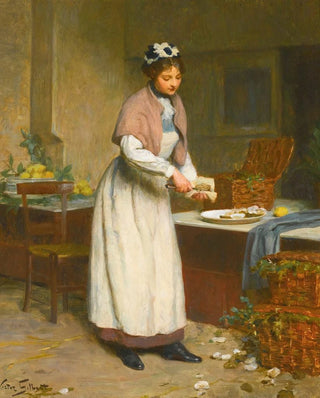Art print | The oyster seller - Victor Gabriel Gilbert


View from behind

Frame (optional)
In the vibrant world of 19th-century French painting, "The Oyster Seller" by Victor Gabriel Gilbert stands out for its charm and striking realism. This artwork, emblematic of the naturalist movement, immerses us in a scene of everyday life where simplicity and authenticity blend with rare delicacy. Gilbert, through this depiction, invites us to contemplate not only the subject but also the lively atmosphere of the Parisian market, where colors and textures seem to come alive under the artist's brush. The seller, the central figure of the canvas, embodies not only daily labor but also a certain poetry of everyday life, making this piece deeply touching and timeless.
Style and uniqueness of the work
Victor Gabriel Gilbert's style is characterized by an exceptional mastery of chiaroscuro and meticulous attention to detail. In "The Oyster Seller," the nuances of light and shadow play a crucial role, creating an ambiance that is both lively and intimate. Warm, earthy tones, combined with touches of brighter colors for the oysters and accessories, contribute to a harmonious composition that captures the eye. The posture of the seller, both proud and humble, reflects profound humanity, while the expressions of passersby in the background add a narrative dimension to the work. Gilbert manages to transcend a simple genre scene to offer a reflection on the human condition, on work and dignity, while celebrating the beauty of everyday life.
The artist and his influence
Victor Gabriel Gilbert, born in 1847, was a painter whose work was greatly influenced by realism and impressionism. Raised in an artistic environment, he mastered the techniques of his contemporaries while developing a distinctive style. His ability to capture scenes of urban life, particularly modest trades, made him a respected figure in the art world. Gilbert was also a passionate advocate of plein air painting, a movement that revolutionized how artists perceived and depicted their environment.

Matte finish

View from behind

Frame (optional)
In the vibrant world of 19th-century French painting, "The Oyster Seller" by Victor Gabriel Gilbert stands out for its charm and striking realism. This artwork, emblematic of the naturalist movement, immerses us in a scene of everyday life where simplicity and authenticity blend with rare delicacy. Gilbert, through this depiction, invites us to contemplate not only the subject but also the lively atmosphere of the Parisian market, where colors and textures seem to come alive under the artist's brush. The seller, the central figure of the canvas, embodies not only daily labor but also a certain poetry of everyday life, making this piece deeply touching and timeless.
Style and uniqueness of the work
Victor Gabriel Gilbert's style is characterized by an exceptional mastery of chiaroscuro and meticulous attention to detail. In "The Oyster Seller," the nuances of light and shadow play a crucial role, creating an ambiance that is both lively and intimate. Warm, earthy tones, combined with touches of brighter colors for the oysters and accessories, contribute to a harmonious composition that captures the eye. The posture of the seller, both proud and humble, reflects profound humanity, while the expressions of passersby in the background add a narrative dimension to the work. Gilbert manages to transcend a simple genre scene to offer a reflection on the human condition, on work and dignity, while celebrating the beauty of everyday life.
The artist and his influence
Victor Gabriel Gilbert, born in 1847, was a painter whose work was greatly influenced by realism and impressionism. Raised in an artistic environment, he mastered the techniques of his contemporaries while developing a distinctive style. His ability to capture scenes of urban life, particularly modest trades, made him a respected figure in the art world. Gilbert was also a passionate advocate of plein air painting, a movement that revolutionized how artists perceived and depicted their environment.






